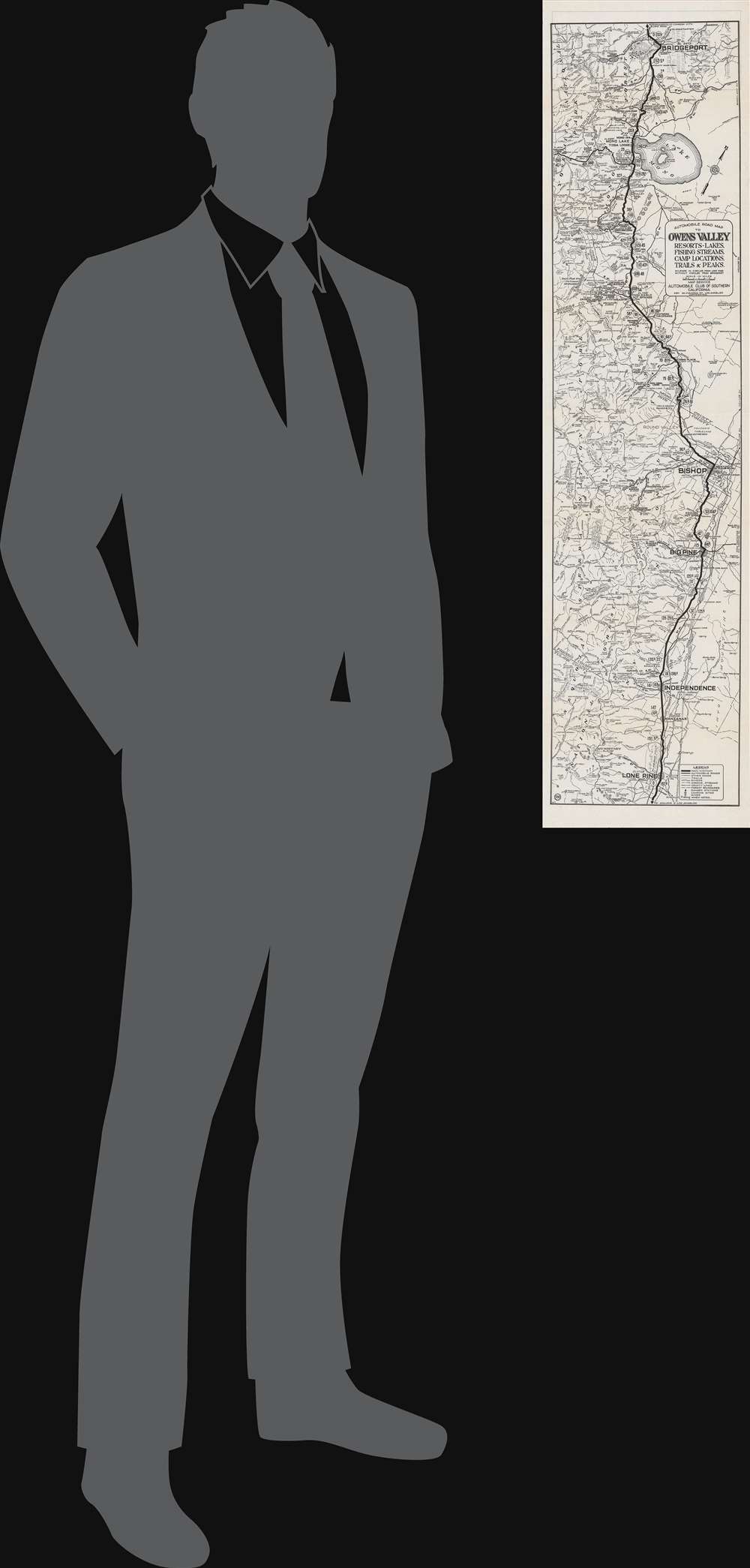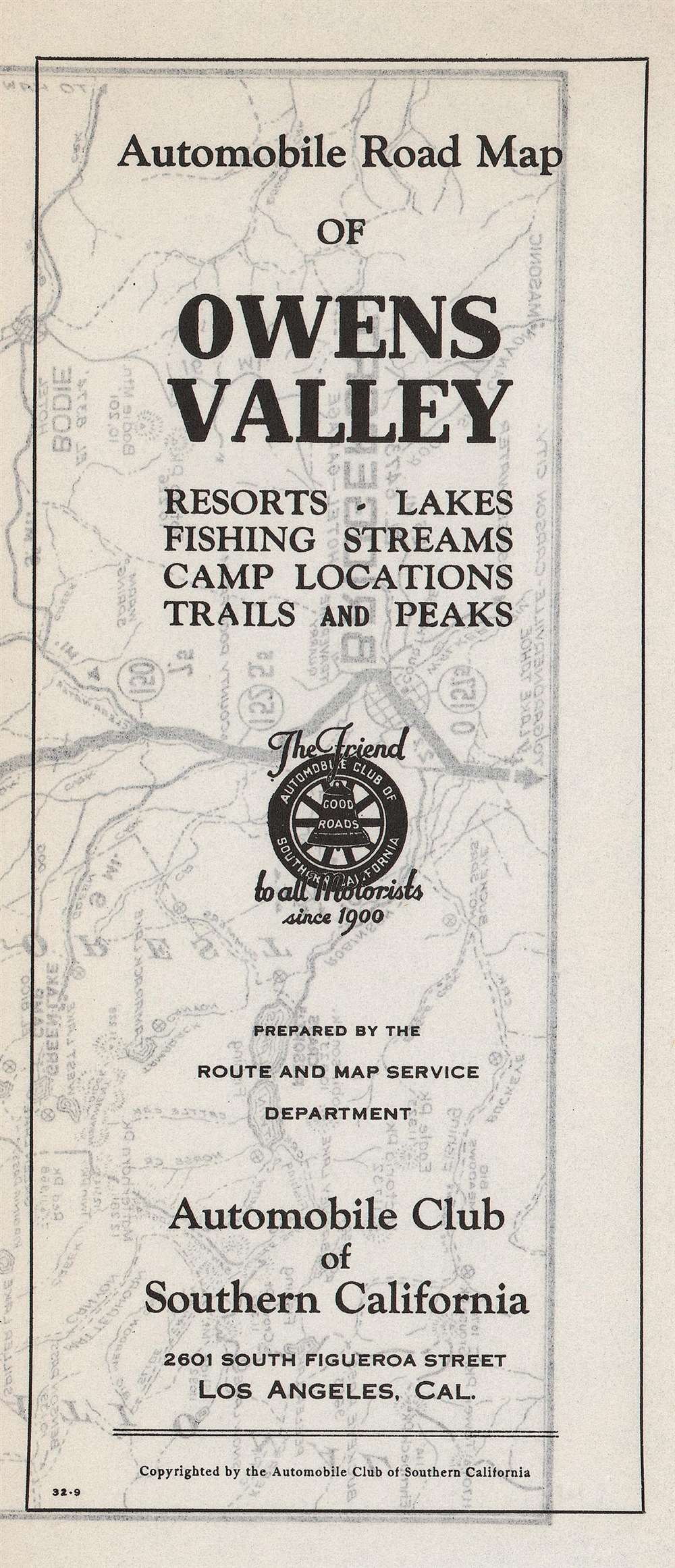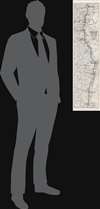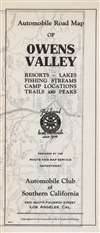This item has been sold, but you can get on the Waitlist to be notified if another example becomes available, or purchase a digital scan.
1930 Auto Club of Southern California Strip Map, Owens Valley
OwensValley-autoclubsocal-1930
Title
1930 (undated) 38 x 9.5 in (96.52 x 24.13 cm) 1 : 250000
Description
A Closer Look
The route depicted skirts along the eastern edge of the Sierra Nevada in Inyo and Mono Counties, passing near a series of famous lakes and mountains, as well as National Forests and Parks, including Sequoia, Sierra, and Yosemite. The numbers in circles along the route indicate distances from Lone Pine heading north, while the numbers not encircled denote distances heading south from Bridgeport. Lone Pine, Big Pine, and other towns along the route were and remain ideal for tourism purposes given their proximity to the natural wonders nearby.This route follows the historic El Camino Sierra, later called the 'Sierra Highway' (today mostly S.R. 14 and U.S. Route 395). The previously little-known route was promoted as a scenic tourist highway in the early 20th century. However, travel would still have been difficult when this map was published because not all roads were paved and travelers passed through a range of rugged, even dangerous, terrains and climates.
Among the settlements passeeed is Manzanar, the site of the first internment camp for Japanese-Americans during World War II, which housed more than 10,000 people at its peak, mostly from the Los Angeles area. The camp's intense summertime heat and frigid nighttime winds were seared in the memories of former detainees, who worked tirelessly after the war to have the former camp designated a National Historic Site, which it was in 1992.
California Water Wars
The promotion of tourism to this region by the Automobile Club of Southern California, based in Los Angeles, was unwittingly callous as these areas had recently been drained of water by the growing metropolis to the south. In the early 20th century, the rapidly expanding city of Los Angeles began to acquire land and water rights to build a long aqueduct across the Mojave Desert, which proved instrumental in the city's continued growth. L.A. was aided by President Theodore Roosevelt and the federal government, who prevented further development of the Owens Valley by creating Inyo National Forest, which in fact contained few trees aside from those planted by farmers. Often using underhanded methods, the city diverted so much water from the Owens River and Owens Lake that the economy and ecosystem of Owens Valley was destroyed in a matter of years, causing farmers in the region to physically attack the aqueduct. By 1926, Owens Lake had dried up completely and by the early 1940s the city also started to divert water that fed Mono Lake. The 'California Water Wars', fictionalized and immortalized in Roman Polanski's 1974 film Chinatown, set Los Angeles and Southern California on a path towards unsustainable suburban sprawl and water usage, which has also consumed much of the Colorado River, among others.Publication History and Census
This map was made by 'W.T.,' probably W. Taylor, of the Automobile Club of Southern California around the year 1930. The Automobile Club produced dozens if not hundreds of these distinctive 'strip maps' or sectional road maps in the 1920s - 1940s. Each was seemingly printed in a small run, and they are difficult to find today. This map is held by five universities in the United States and is very scarce to the market.Cartographer
The Automobile Club of Southern California (1900 - Present) is an auto club based in Los Angeles, California and an affiliate of the American Automobile Association (AAA). Founded in 1900, it was one of the first auto clubs in the United States and was dedicated to proposing traffic laws, improving road conditions, and the overall improvement of driving conditions. The Auto Club began producing its own maps in 1910, when it sent out its own team of cartographers to survey the state's roads. Its main office at the corner of Figueroa Street and Adams Boulevard was completed in 1923. Numbering nearly 8 million members in its home territory alone, today it is the largest single member of the AAA federation More by this mapmaker...






